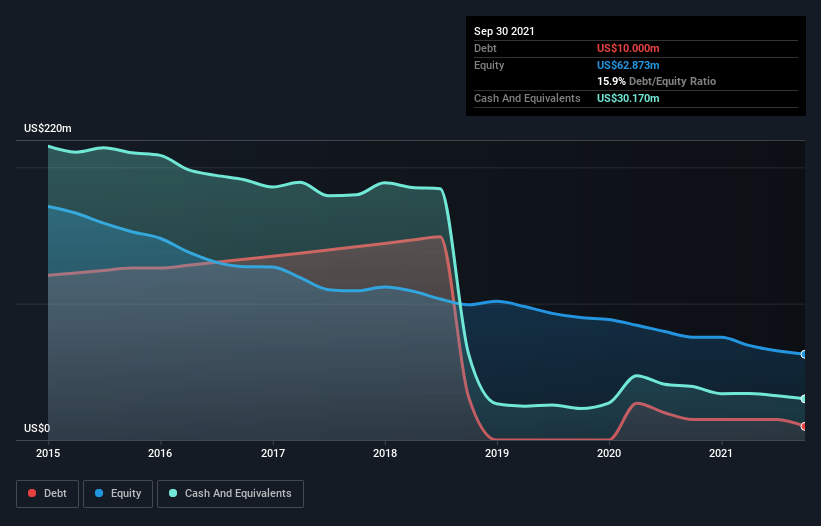- United States
- /
- IT
- /
- NasdaqGS:SREV
Is ServiceSource International (NASDAQ:SREV) Using Debt In A Risky Way?
The external fund manager backed by Berkshire Hathaway's Charlie Munger, Li Lu, makes no bones about it when he says 'The biggest investment risk is not the volatility of prices, but whether you will suffer a permanent loss of capital.' When we think about how risky a company is, we always like to look at its use of debt, since debt overload can lead to ruin. We can see that ServiceSource International, Inc. (NASDAQ:SREV) does use debt in its business. But the more important question is: how much risk is that debt creating?
Why Does Debt Bring Risk?
Generally speaking, debt only becomes a real problem when a company can't easily pay it off, either by raising capital or with its own cash flow. Part and parcel of capitalism is the process of 'creative destruction' where failed businesses are mercilessly liquidated by their bankers. However, a more frequent (but still costly) occurrence is where a company must issue shares at bargain-basement prices, permanently diluting shareholders, just to shore up its balance sheet. Of course, plenty of companies use debt to fund growth, without any negative consequences. When we examine debt levels, we first consider both cash and debt levels, together.
See our latest analysis for ServiceSource International
How Much Debt Does ServiceSource International Carry?
As you can see below, ServiceSource International had US$10.0m of debt at September 2021, down from US$15.0m a year prior. However, it does have US$30.2m in cash offsetting this, leading to net cash of US$20.2m.

How Strong Is ServiceSource International's Balance Sheet?
The latest balance sheet data shows that ServiceSource International had liabilities of US$45.8m due within a year, and liabilities of US$20.8m falling due after that. On the other hand, it had cash of US$30.2m and US$35.5m worth of receivables due within a year. So these liquid assets roughly match the total liabilities.
Having regard to ServiceSource International's size, it seems that its liquid assets are well balanced with its total liabilities. So while it's hard to imagine that the US$109.0m company is struggling for cash, we still think it's worth monitoring its balance sheet. While it does have liabilities worth noting, ServiceSource International also has more cash than debt, so we're pretty confident it can manage its debt safely. When analysing debt levels, the balance sheet is the obvious place to start. But you can't view debt in total isolation; since ServiceSource International will need earnings to service that debt. So if you're keen to discover more about its earnings, it might be worth checking out this graph of its long term earnings trend.
Over 12 months, ServiceSource International made a loss at the EBIT level, and saw its revenue drop to US$191m, which is a fall of 3.8%. We would much prefer see growth.
So How Risky Is ServiceSource International?
Statistically speaking companies that lose money are riskier than those that make money. And in the last year ServiceSource International had an earnings before interest and tax (EBIT) loss, truth be told. Indeed, in that time it burnt through US$3.9m of cash and made a loss of US$19m. But the saving grace is the US$20.2m on the balance sheet. That kitty means the company can keep spending for growth for at least two years, at current rates. Overall, we'd say the stock is a bit risky, and we're usually very cautious until we see positive free cash flow. There's no doubt that we learn most about debt from the balance sheet. However, not all investment risk resides within the balance sheet - far from it. Case in point: We've spotted 2 warning signs for ServiceSource International you should be aware of.
When all is said and done, sometimes its easier to focus on companies that don't even need debt. Readers can access a list of growth stocks with zero net debt 100% free, right now.
New: Manage All Your Stock Portfolios in One Place
We've created the ultimate portfolio companion for stock investors, and it's free.
• Connect an unlimited number of Portfolios and see your total in one currency
• Be alerted to new Warning Signs or Risks via email or mobile
• Track the Fair Value of your stocks
This article by Simply Wall St is general in nature. We provide commentary based on historical data and analyst forecasts only using an unbiased methodology and our articles are not intended to be financial advice. It does not constitute a recommendation to buy or sell any stock, and does not take account of your objectives, or your financial situation. We aim to bring you long-term focused analysis driven by fundamental data. Note that our analysis may not factor in the latest price-sensitive company announcements or qualitative material. Simply Wall St has no position in any stocks mentioned.
Have feedback on this article? Concerned about the content? Get in touch with us directly. Alternatively, email editorial-team (at) simplywallst.com.
About NasdaqGS:SREV
ServiceSource International
ServiceSource International, Inc. provides business process-as-a-service solutions worldwide.
Flawless balance sheet and slightly overvalued.
Similar Companies
Market Insights
Community Narratives


Recently Updated Narratives


MINISO's fair value is projected at 26.69 with an anticipated PE ratio shift of 20x


The Quiet Giant That Became AI’s Power Grid


Nova Ljubljanska Banka d.d will expect a 11.2% revenue boost driving future growth
Popular Narratives


The company that turned a verb into a global necessity and basically runs the modern internet, digital ads, smartphones, maps, and AI.


MicroVision will explode future revenue by 380.37% with a vision towards success



